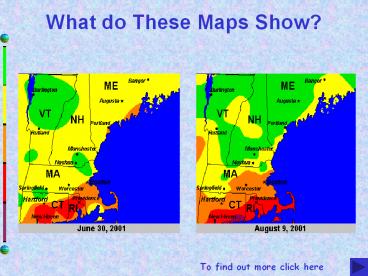What do These Maps Show? - PowerPoint PPT Presentation
1 / 21
Title:
What do These Maps Show?
Description:
Air Pollution. The maps you just saw. show ozone smog levels on ... Air ... matter are two types of Air Pollution that affect Maine. What is Ozone? ... – PowerPoint PPT presentation
Number of Views:51
Avg rating:3.0/5.0
Title: What do These Maps Show?
1
What do These Maps Show?
To find out more click here
2
Air Pollution
- The maps you just saw show ozone smog levels on
two days last summer. - This map shows the highest ozone levels
recorded in 2001.
3
Where Did Acadia Go?
Keep clicking.
4
Air Pollution Reduces Visibility
Acadia National Park A Clear Day vs A Hazy
Day
- To learn more about ozone and fine particles,
click the arrow in the corner.
5
Air Pollution
- Has many effects on public health
and the environment. - Comes in different forms and from many sources.
- Ozone and Particulate matter are two types of Air
Pollution that affect Maine.
6
What is Ozone?
- An odorless, colorless gas composed of three
oxygen atoms.
- Ozone in the upper atmosphere protects us from
the suns harmful ultraviolet rays.
- At ground-level in the air we breathe, ozone
(smog) poses serious risks to human health.
7
Where Does Ozone Come From?
- Ozone is created by a chemical reaction
VOC NOx Heat Sunlight Ozone
VOC (Volatile Organic Compounds) and NOx
(Nitrogen Oxides) come from motor vehicles,
power plants, industrial facilities, and other
sources.
8
Why is Ozone Bad to Breathe?
- The average adult breathes enough air to fill
over 3,000 balloons each day. Children breathe
even more! - Ozone can irritate lungs and airways, and cause
inflammation much like a sunburn on your lungs. - Ozone can aggravate respiratory illnesses like
asthma. - 10 to 20 of summertime respiratory-related
hospital visits in the Northeast are associated
with ozone pollution. - Children and people with chronic lung diseases
are particularly at risk.
9
Health Effects of Exposure to Ozone
- Coughing
- Nose and throat irritation
- Chest pain
- Reduced lung function
- Increased susceptibility to respiratory illnesses
- Aggravation of asthma
10
The Air Quality Index
11
What Makes a Bad Ozone Day in New England?
12
Ozone Trends in Maine
13
Smog Alert Service
- Notifies you by e-mail or fax when ozone levels
are predicted to be unhealthy in your area. - Is available in most areas in New England.
- Is a free service.
- To receive Smog Alerts, register at
(www.epa.gov/region01/oms) - Or contact Maine DEPs
- Ozone Hotline at 1-800-223-1196 or
- www.state.me.us/dep/air/ozone/ozone.htm
14
What is Particulate Matter?
- particles of different substances suspended in
the air - in the form of solid particles and liquid
droplets - particles vary widely in size
15
Where does Pm come from?
- Fine particles come from a variety of sources
- diesel trucks and buses
- construction equipment
- power plants
- woodstoves
- wildfires
- Also, Chemical reactions in the atmosphere
- can transform gases into fine particles.
16
How Fine is Fine?
- Fine particles are only a fraction
- of the size of a human hair.
17
Why are Fine ParticlesBad to Breathe?
- Scientific studies have linked fine particles
with a series of significant health problems. - Fine particles easily reach the deepest parts of
the lungs. - Particulate matter causes 15,000 premature deaths
every year in the US. - Fine particles from Diesel exhaust can cause lung
cancer.
18
Health Effects of Exposure to Fine Particles
- Premature death
- Aggravated asthma
- Respiratory-related emergency room visits and
hospital admissions - Acute respiratory symptoms
- Chronic bronchitis
- Decreased lung function (shortness of breath)
- People with existing heart and lung disease, as
well as the elderly and children, are
particularly at risk
19
What Can You Do?
- Reduce vehicle emissions
- Drive less
- Keep cars well maintained and tires properly
inflated - Turn off the engine when your vehicle is not in
motion - Purchase low-emitting and fuel efficient vehicles
- Share a ride, take public transportation bike, or
walk - Cut your grass after 6 p.m.
- Refuel your car after 6 p.m.
- Combine errands into one trip
?
20
What Can You Do?
- Conserve electricity
- do not over-cool or over-heat buildings
- turn off lights and appliances when not in use
- Purchase electronics/appliances with energy star
labels
To protect your health, avoid strenuous outdoor
activities when ozone levels are high
21
This presentation was made possible by
The Maine Department of Environmental Protection
(www.state.me.us/dep)
The United States Environmental Protection
Agency (www.epa.gov)































